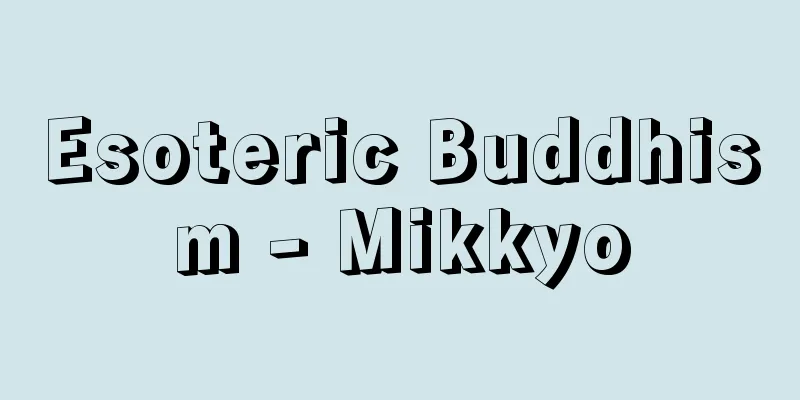Esoteric Buddhism - Mikkyo

|
A sect of Buddhism. It is also called Secret Buddhism or Shingon Esoteric Buddhism, as opposed to Exoteric Buddhism. [Katsumata Toshinori] HistoryIt is a sect that suddenly emerged towards the end of Indian Mahayana Buddhism (in the second half of the 7th century) and was based on the ideas of the Mahayana Buddhist "Hannya Sutra" and "Avatamsaka Sutra", as well as the Madhyamaka and Yogacara schools, and was further influenced by Hinduism. It is thought that the independence of this esoteric Buddhism was due to the establishment of the "Mahavairocana Sutra" and the "Vajrasekhara Sutra". However, many esoteric scriptures were written before that time, and the seeds of esoteric Buddhism are thought to date back even further to the Vedic period. In the Vedic period, people would recite mantras (sacred words) to pray for protection from disasters and for good fortune, and later the idea of viewing mantras as sacred also emerged. In the early Buddhist sects, secular magic and esoteric practices for healing, prolonging life, and bringing good fortune were strictly prohibited, but later there was a tendency to accept these magic and esoteric practices, and in the Mahayana period, dharani (dhāranī) and lucid mantras (vidya) began to be preached in the Mahayana scriptures, and independent esoteric mantra scriptures were also written. These esoteric scriptures also included the teachings of offerings, the practice of creating a barrier, the goma ritual, mudra, dharani, and mandalas, but as these are not part of the mainstream of Buddhism, they are called miscellaneous esoteric Buddhism. Later, around 650-700, the Mahavairocana Sutra and the Vajrasattva Sutra were created, emphasizing the rapid attainment of Buddhahood (instantaneous attainment of Buddhahood) through esoteric practices, and so this is called pure esoteric Buddhism, which is considered to be an independent form of esoteric Buddhism. According to traditional legend, the secret teachings of Shingon Esoteric Buddhism were passed down from Mahavairocana to Vajrasattva, who then passed them on to Ryumyo and Ryuchi, but this is not historically clear. Indian esoteric Buddhism later came to be called Shingon-yana or Vajrayana and developed for several centuries, but gradually lost its original character and became Left-Hand Path Esoteric Buddhism, or Tantric Buddhism, which incorporated theories from Hindu Shakta (sexual power) sects, and then declined with the invasion of Muslims in the early 13th century. In China, esoteric Buddhist scriptures containing elements of dharani and magic were translated by Mitara Hakushiri and Donmulan during the Eastern Jin Dynasty, and were then transmitted intermittently through the Northern and Southern Dynasties, Sui, and early Tang Dynasty. However, full-scale introduction of esoteric Buddhism was from the beginning to the middle of the 8th century. During the Tang Dynasty, Shanwuwei and Kongochi came to China in succession, and Shanwuwei translated the Mahavairocana Sutra and Kongochi translated the Vajrapani Sutra, providing China with a systematic system of esoteric Buddhist scriptures. Furthermore, Amoghavajra went to Ceylon (Sri Lanka) to study esoteric Buddhism, and upon returning to China, he translated many scriptures, including over 80 esoteric Buddhist scriptures, perfecting esoteric Buddhism and earning the strong trust of Emperors Xuanzong, Suzong, and Daizong of the Tang Dynasty. Among Fuku's disciples, Huiguo mastered the mysteries of Shingon Esoteric Buddhism and in his later years transmitted its true lineage to Kukai, who traveled to China from Japan. Esoteric Buddhism in China developed rapidly with the power of the Tang Dynasty as its backdrop, but gradually declined at the end of the Tang Dynasty. Esoteric Buddhist scriptures were introduced to Japan during the Nara period, and esoteric Buddhist rituals, chanting of Dharani, and worship of esoteric Buddhist statues were practiced. At the beginning of the Heian period, the pure esoteric Buddhism of the Tang Dynasty was introduced by Kobo Daishi Kukai, who reorganized and Japanized it to establish Shingon Buddhism as a sect of Japanese Buddhism. Esoteric Buddhism introduced by Tendai sect members such as Dengyo Daishi Saicho, Jikaku Daishi Ennin, and Chisho Daishi Enchin established a unique esoteric Buddhism that emphasized the unity of Tendai and esoteric Buddhism. Therefore, the esoteric Buddhism of Shingon Buddhism is called Tomitsu (Toji esoteric Buddhism), while the esoteric Buddhism of Tendai Buddhism is called Taimitsu. Kukai then established the teachings on the two schools of esoteric Buddhism, exoteric and esoteric, as well as the teachings on the Ten Stages of Mind, thereby clarifying the characteristics of esoteric Buddhism. On the other hand, Indian esoteric Buddhism was introduced to Tibet by Padmasambhava at the end of the 8th century, and this esoteric Buddhism was eventually assimilated with the ethnic Bon religion to become Tibetan Buddhism (Lamaism). Later, in 1042, Atisha entered Tibet and reformed Tibetan Buddhism, which spread to Mongolia and the northeastern region of China. [Katsumata Toshinori] FeaturesI will focus on the notable characteristics of Japanese esoteric Buddhism. (1) In terms of the view of Buddha, Mahavairocana (Makabirushana) is regarded as the principal Buddha, and a pantheistic, unified view of Buddha is constructed in which many Buddhas, bodhisattvas, Myo-o, and heavenly beings are all manifestations of Mahavairocana. As a way of intuitively expressing this, an assembly of many Buddhas is depicted in a diagram. This is called a mandala. There are two types of mandalas: the Vajrayana mandala and the Garbha-kai mandala, which are collectively called the Ryōkai mandala. In addition, mandalas that show a single deity such as a Buddha, bodhisattva, or Myo-o and its attendants are called separate deity mandalas. In addition, Dainichi Nyorai is regarded as the deity of universal virtue, while Buddha, Bodhisattva, Myo-o, etc. are regarded as the deities of individual virtue, and it is believed that worshiping any one of these deities ultimately unifies one's faith in Dainichi Nyorai. This is called "Ichimon ikkaku fumon." (2) When worshiping these deities, one recites mantras and dharani. Mantra means true words, and is a secret word used to praise the deities or to devote oneself to the deities, and is also called myoju. Dharani is translated as "souji" and means to contemplate deep religious meanings and unify the mind through specific phrases, but later it came to be used in the same way as mantra, and is called Shingon dharani. It was believed that by reciting this mantra dharani, one would gain miraculous powers and be able to eliminate worldly desires. Esoteric Buddhism is called Shingon esoteric Buddhism or Shingon dharani sect, and the name Shingon sect comes from the emphasis on mantras and dharani. (3) When worshipping the various deities, one is supposed to make mudras. Mudras are a way of symbolically showing the inner knowledge and original vows of Buddha, Bodhisattva, and Myo-o by clasping the fingers. (4) In esoteric Buddhism, there are also rituals such as offerings to the various deities, goma (fire) and kanjo (ablution) ceremonies, and there are many rituals that prescribe these. (5) It is believed that each person has a pure bodhi mind of innate enlightenment, and it is taught that one should awaken this bodhi mind, maintain the precepts unique to esoteric Buddhism called the sammaya precepts, and practice the Ten Good Precepts. (6) They emphasize instantaneous enlightenment (quick enlightenment) and teach that one can attain enlightenment in this very body through the practice of samādhi. For this, they suggest various methods of training, such as contemplation of the five characteristics of the body, contemplation of the Aji character, contemplation of the moon disc, and the wonderful practice of the three mysteries. In this way, Esoteric Buddhism inherited the orthodox ideas of Mahayana Buddhism while also creating its own unique religious form. To summarize, Esoteric Buddhism has both doctrine and practice, which are said to be like the two wheels of a car or the two wings of a bird, and it respects the religious experience shown on the basis of the harmony of these two aspects, and was established and developed as a new practical and faith-based Buddhism in place of Mahayana Buddhism, which was religiously fixed and theorized. Looking now at the most basic form of this faith, Kukai, in "The Meaning of Instantaneous Buddhahood," teaches that anyone with esoteric Buddhism can attain Buddhahood in this very body by chanting mantras, making mudras with his hands, and placing his mind in the Buddha's samachi (the state of enlightenment), and the three mysteries of body, speech, and mind of the Buddha and the three mysteries of body, speech, and mind of the practitioner will naturally resonate with each other through the blessings and influences, and so will be able to attain Buddhahood in this very body and also to fulfill desires for worldly benefits. Esoteric Buddhism also developed its own unique esoteric art. There are no ruins or remains in India or China, so it is unknown, but in Japan, many remains remain. [Katsumata Toshinori] "The History of Esoteric Buddhism" by Matsunaga Yukie (1969, Heirakuji Shoten)" ▽ "The Philosophy of Esoteric Buddhism" by Kanaoka Hidetomo (1969, Heirakuji Shoten)" ▽ "The Development of Esoteric Buddhism in Japan" by Katsumata Toshinori (1970, Shunjusha)" ▽ "Lectures on Esoteric Buddhism 1-12" (1974-77, Heikawa Publishing) [References] | | | | |Source: Shogakukan Encyclopedia Nipponica About Encyclopedia Nipponica Information | Legend |
|
仏教の一流派。顕教(けんぎょう)に対しての呼称で、秘密仏教、真言(しんごん)密教ともいう。 [勝又俊教] 沿革インド大乗仏教の末期(7世紀後半)ににわかに興起した一流派で、大乗仏教の『般若(はんにゃ)経』や『華厳(けごん)経』の思想や中観(ちゅうがん)派、瑜伽行(ゆがぎょう)派などの思想を基盤とし、さらにヒンドゥー教の影響を受けて成立したものであり、この密教の独立は『大日(だいにち)経』や『金剛頂経(こんごうちょうぎょう)』の成立によると考えられる。 しかし、それより以前にも多くの密教系の経典が成立しており、さらに密教の萌芽(ほうが)は遠くベーダ時代にさかのぼるとみられる。すなわち、ベーダ時代にマントラmantra(真言)を誦(ず)して攘災(じょうさい)招福を祈ることが行われ、その後マントラを神聖視する思想も現れている。原始仏教教団では、治病、延命、招福など世俗の呪術(じゅじゅつ)や密法を厳禁したが、その後にはこれらの呪術や密法を認める傾向が現れ、大乗仏教時代には、大乗経典のなかに陀羅尼(だらに)(ダーラニーdhāranī)、明呪(みょうじゅ)(ビディヤーVidyā)が説かれるようになり、また独立の密呪経典も成立した。それらの密呪経典には供養法、結界作壇(さだん)法、護摩法や印契(いんげい)、陀羅尼、曼荼羅(まんだら)なども説かれるようになったが、それらは仏教の本流ではないので、それらを雑部密教(雑密(ぞうみつ))という。その後、650~700年ごろに『大日経』と『金剛頂経』が成立し、密教的実践による速疾成仏(そくしつじょうぶつ)(即身(そくしん)成仏)を強調したので、これを純粋密教(純密)といい、これをもって密教の独立とする。従来の伝説では、真言密教は、大日如来(にょらい)が自ら悟った秘密の法を金剛薩埵(こんごうさった)に授け、それからさらに龍猛(りゅうみょう)、龍智(りゅうち)へと伝えられたと説くが、歴史的には明確でない。インド密教はその後、真言乗や金剛乗などといわれ、数世紀の間発展したが、しだいに本来の性格を失って、ヒンドゥー教のシャークタ派(性力派)などの説を取り入れた左道(さどう)密教、いわゆるタントラ仏教となり、13世紀初めイスラム教徒の侵入とともに衰滅した。 中国には、陀羅尼や呪術的要素を内包した密教的経典が、東晋(とうしん)代の帛尸梨密多羅(はくしりみったら)や曇無蘭(どんむらん)などによって訳され、その後、南北朝、隋(ずい)、初唐まで断続的に中国に伝えられていた。しかし本格的な密教の導入は、8世紀初めからなかばごろにかけてである。唐代に善無畏(ぜんむい)、金剛智(こんごうち)が順次に来唐し、善無畏が『大日経』を、金剛智が『金剛頂経』を翻訳して中国に組織的な密教経典が備わった。さらに不空はセイロン(スリランカ)に渡って密教を学び、帰国して80余部の密教経典をはじめ数多くの経典を訳して密教を大成、唐代の玄宗、粛宗、代宗の厚い信任を受けた。不空の弟子のうち恵果(けいか)は真言密教の秘奥を究め、晩年、日本から入唐(にっとう)した空海にその正系を伝えた。中国の密教は唐朝の権力を背景に急速に発展したが、唐末しだいに衰微した。 日本には、奈良時代に密教経典が伝えられ、密教の修法、陀羅尼誦持(だらにじゅじ)、密教像の信仰など行われていたが、平安時代の初めに弘法大師(こうぼうだいし)空海によって唐代の純粋密教が伝えられ、さらに空海によって再組織され、日本化されて日本仏教の一宗としての真言宗が開かれた。また、伝教(でんぎょう)大師最澄(さいちょう)、慈覚(じかく)大師円仁(えんにん)、智証(ちしょう)大師円珍(えんちん)ら天台宗の人々によって伝えられた密教は、天台と密教との一致を強調する特異の密教を成立せしめた。そこで、真言宗の密教を東密(とうみつ)(東寺の密教)というのに対して、天台宗の密教を台密(たいみつ)という。そして、空海は顕密二教の教判をたて、あるいは十住心の教判をたてて、密教の特質を明らかにした。 他方、インド密教は8世紀末にパドマサンババによりチベットに伝えられ、この密教はやがて民族宗教のボン教と習合してチベット仏教(ラマ教)となった。その後、1042年にアティーシャがチベットに入り、チベット仏教を改革、チベット仏教は蒙古(もうこ)(モンゴル)、中国東北地方に広められた。 [勝又俊教] 特色日本の密教を中心としてその著しい特色をあげてみる。(1)仏陀(ぶっだ)観としては、大日如来(摩訶毘盧遮那(まかびるしゃな)如来)を本仏とし、多くの仏、菩薩(ぼさつ)、明王、天などをすべて大日如来の化現したものとみる汎(はん)神論的、統一的仏陀観を構成し、これを直観的に表示する方法として諸仏の集会を図式に表した。これを曼荼羅(マンダラmaala)という。この曼荼羅には金剛界曼荼羅と胎蔵界曼荼羅とがあり、これをあわせて両界曼荼羅という。このほかに、仏、菩薩、明王などの一尊とその眷属(けんぞく)を表示したものを別尊曼荼羅という。また大日如来を普門総徳の本尊とし、仏、菩薩、明王などを一門別徳の本尊とし、いずれの一尊を拝んでも結局大日如来の信仰に統一されると考える。これを一門即普門という。(2)これら諸尊を信仰するときに、真言、陀羅尼を唱える。真言(マントラmantra)は真実のことばの意味であり、諸尊を賛嘆し、あるいは諸尊に帰依(きえ)する秘密語であり、明呪ともいう。陀羅尼は総持と訳され、特定の文句によって宗教上の深い意味を憶念し、心を統一する意味であるが、のちには真言と同様に用いられ、真言陀羅尼という。この真言陀羅尼を誦持すれば、不思議な力が得られ、煩悩(ぼんのう)を滅除することができると信じられた。密教を真言密教といい、真言陀羅尼宗といい、真言宗というのは、真言、陀羅尼を重視するからである。(3)また諸尊を信仰するとき、印契(いんげい)(ムドラーmudrā)を結ぶことになっている。印契(印相)とは仏、菩薩、明王などの内証、本誓を象徴的に手指の結び方で示す方法である。(4)また密教では諸尊の供養法や護摩(ごま)法、灌頂(かんじょう)の儀式などが行われ、それらを規定した多くの儀軌(ぎき)がある。(5)人にはそれぞれ本有本覚(ほんうほんがく)の浄菩提心(じょうぼだいしん)があると信じ、菩提心をおこし、三昧耶(さんまいや)戒という密教特有の戒を保ち、十善戒を実践すべきことを説く。(6)即身成仏(速疾成仏)を強調し、三摩地(さんまじ)(サマーディsamādhi)の行によって即身成仏しうると説くが、これには五相成身観、阿字(あじ)観、月輪(がちりん)観や三密の妙行などいろいろな修行の方法が示されている。 このように密教は大乗仏教の正統な思想を受け継ぎながら、また独自の宗教形態を打ち出している。これを要約すれば、密教は教相(きょうそう)(教理)と事相(じそう)(実践)の両面をもち、この教相と事相は車の両輪、鳥の双翼のごとくであるといわれ、この両面の調和のうえに示された宗教体験を尊重し、宗教的に固定化、理論化した大乗仏教にかわって、新しい実践的、信仰的仏教として成立し発展したものである。いま、そのもっとも基本的な信仰の形態をみるに、空海は『即身成仏義』のなかで、密教の信仰をもつものはだれでも、口に真言を唱え、手に印契を結び、心を仏の三摩地(悟りの境地)に置けば、おのずから仏の身口意(しんくい)の三密と修行者の身口意の三密とが加持感応するから、この身このままに仏になることができ、また世間の現世利益(げんぜりやく)的な願いをかなえることもできると説いている。 また密教は独自の密教美術を発展させた。インド、中国においては遺跡・遺品もなく、不明であるが、日本においては多くの遺品を残している。 [勝又俊教] 『松長有慶著『密教の歴史』(1969・平楽寺書店)』▽『金岡秀友著『密教の哲学』(1969・平楽寺書店)』▽『勝又俊教著『密教の日本的展開』(1970・春秋社)』▽『『講座密教1~12』(1974~77・平河出版社)』 [参照項目] | | | | |出典 小学館 日本大百科全書(ニッポニカ)日本大百科全書(ニッポニカ)について 情報 | 凡例 |
<<: Esoteric Buddhism - Mikkyodate
Recommend
Imasu - I am here
A place name in Fuwa-gun, Mino Province, currently...
toe
…The Chinese character 趾 was used to distinguish ...
Epidemic keratoconjunctivitis
…Of these conjunctivitis, the most important is v...
two ball threesome
… There are other ways to play the game. (1) Two ...
Labor contract - labor contract
A contract in which a worker agrees with an emplo...
Coordinating Committee for Export Control to Communist Area
…Abbreviation for the Coordinating Committee for ...
Topknot under Eboshi hat - Eboshishita no Mototori
…For common people who needed light clothing suit...
Kaden
… Tenant dispute [Abiko Rin] 【China】 In China, th...
Gunn Diode
JB Gunn discovered that when a DC electric field ...
Purusha
A Sanskrit word meaning "man," "hum...
Haller, Albrecht von
Born: October 16, 1708, Bern Died December 12, 177...
Smerinthus tokyonis (English spelling)
…[Hiroshi Inoue]. … *Some of the terminology that...
Koninkrijk Holland (English spelling)
In the 18th century, there were movements by the ...
Plantago virginica (English spelling) Plantagovirginica
…[Yoshiharu Iijima]. … *Some of the terminology t...
Malayalam (English spelling)
...There is a considerable movement of population...
![Irihirose [village] - Irihirose](/upload/images/67caf3864fbad.webp)








